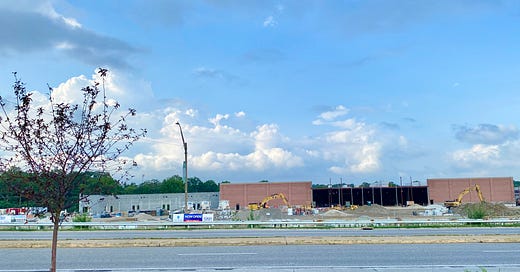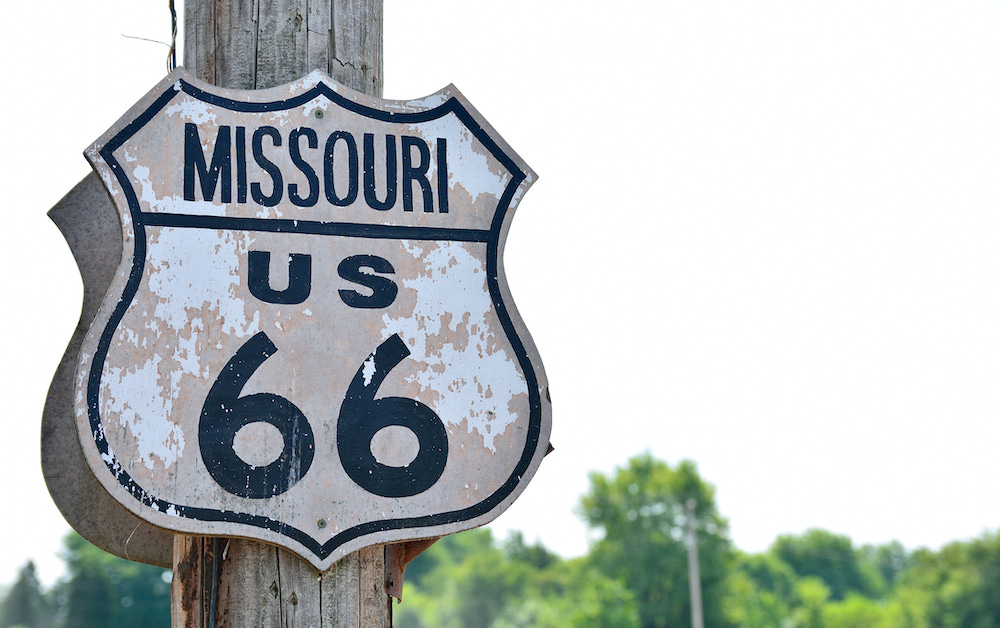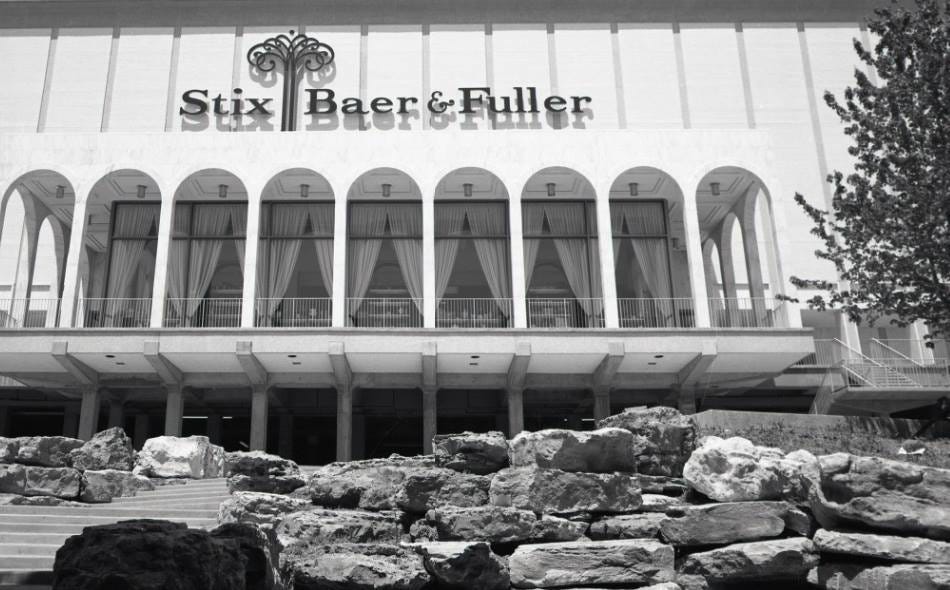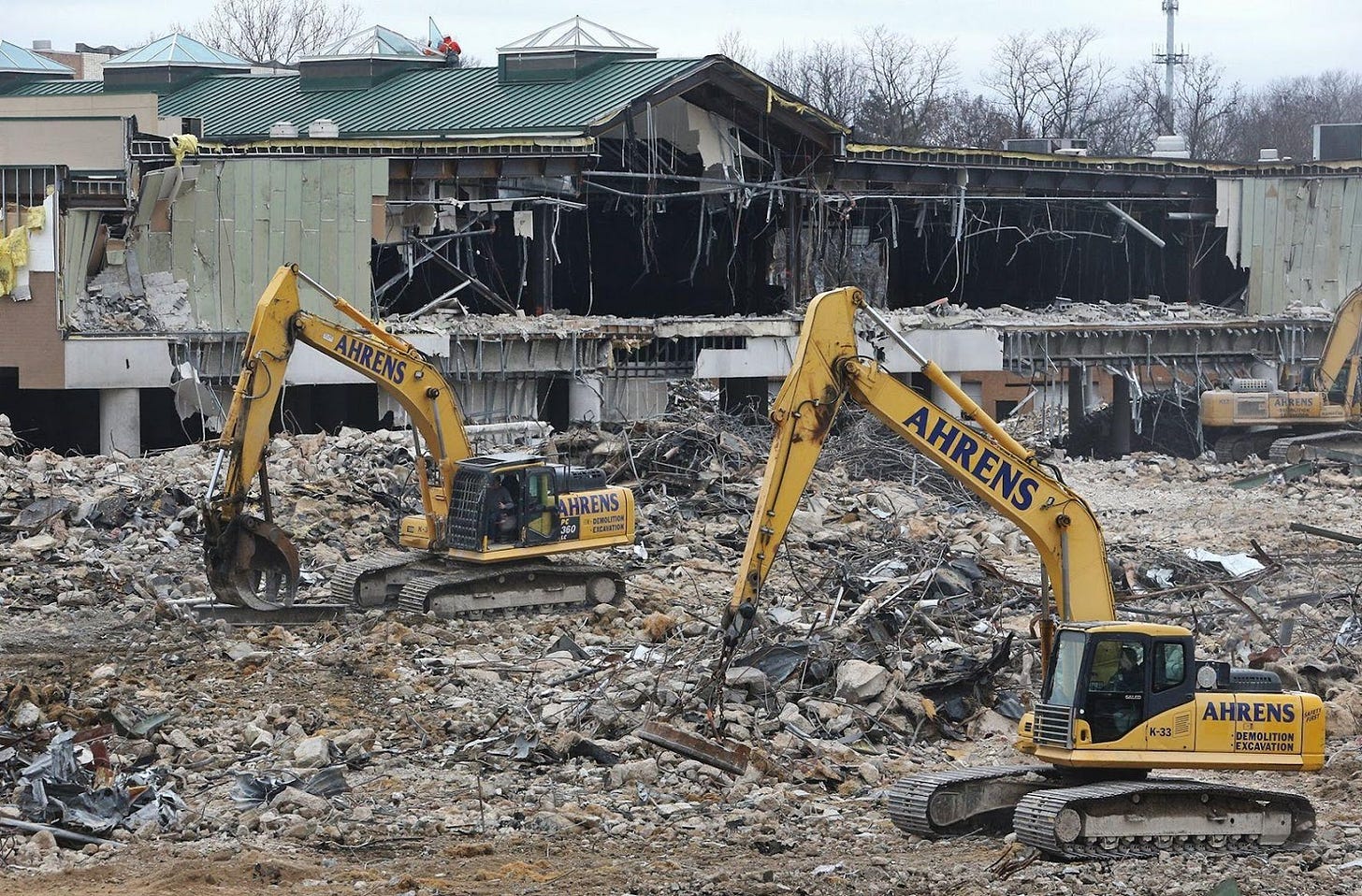Today in Unseen St. Louis I’m going to talk about a shopping mall. Now hold up, don’t click away. The rise and fall — and hopefully, rebirth — of Crestwood Plaza in St. Louis County tells a fascinating story repeated over and over across America.
Rise of suburbia
Before the 1950s, people didn’t go to shopping centers or malls. Depending on where they lived, they headed downtown or to the town square, shopping at what we might call small boutique stores and later, department stores. Department stores grew out of the 19th-century dry goods store, and in St. Louis, we had a bunch of them in downtown St. Louis.
For example, until 2006 you could visit the grand Famous-Barr in the Railway Exchange Building at 615 Olive St. (It later became a Macy’s, until it closed in 2013). Most of these fine establishments sold a variety of items including clothing, tools, cookware, toys, furniture, bedding, and so forth. Other shops would be located nearby for groceries, hardware, books, and so forth. You might walk to the shopping district, or take a streetcar.
But things changed after the end of World War II. With the end of wartime rationing and manufacturing, car ownership increased, highways boomed with the Federal Aid Highway Act of 1956, and people started moving out of dense urban, downtown areas and out to newly-built suburbs. And the old-fashioned skyscraper department store just wouldn’t do.
As one of the new St. Louis suburbs, Crestwood was incorporated in 1947, and in 1949 annexed land just north of Watson. Straddling part of the famed Route 66 (a 2,448-mile stretch of two-lane highway, the first to link Chicago and Los Angeles and all points in between) it was “on the map,” so to speak. When 66 was rerouted from Manchester Road to Chippewa/Watson in 1936, many new businesses (including motels, restaurants, and shops) sprung up to take advantage of the popular travel route (view a fun map of sites in the area). Although there were some homes in the Crestwood area before the war, its population exploded in the decade or so afterward.
To give you an idea of how quickly Crestwood grew, below is a map of approximate building ages near Crestwood Plaza. The big white space in the bottom left is the location of Crestwood Plaza. In the middle of the map, between I-44 at the top and Watson Road (66), the neighborhoods of this part of Crestwood and Webster Groves were largely built in the 1930s through 1950s (mostly post-war/annexation), as denoted by the darker blue color (mauve represents pre-1900 construction, and the lighter blue homes are more recent).

So it’s not surprising that when developers sought a location to build a new-fangled shopping mall, Crestwood, with its growing population of young, white, middle-class residents plus a popular highway route, ticked all the boxes.
A mall is born
Crestwood Plaza started as an outdoor shopping center and was one of the first malls in the St. Louis area when it opened March 21, 1957. Located on 47 acres, it offered two major department stores as anchors and may have been the first to incorporate split-level parking so customers could enter on different floors of the anchor stores.
At the time they broke ground on Crestwood Plaza, the businesses along Route 66 catered more to tourists and travelers, leaving local residents to drive significant distances for shopping purposes. Having such an expansive shopping center really put the community on the map and encouraged city growth.
Some of the stores that opened in the original Crestwood Plaza in 1957-1958 included Walgreens, Kroger, F. W. Woolworth, the Lerner Shop, and Thom McAn Shoes. Sears Roebuck and Co. and Scruggs-Vandervoort-Barney were the two anchor stores, although the latter closed in 1969 and the space was taken over by Famous-Barr (and later by Macy’s).

Peak mall
At its peak, Crestwood Plaza was home to almost 100 stores.
It was a popular shopping destination and so noteworthy that none other than John F. Kennedy gave a speech there on a campaign stop in October 1960. In his speech, he promised to “Strike a blow for freedom.” (Watch a brief silent film clip of his visit.)
Seemingly unstoppable, in January 1967 the mall expanded to add Stix Baer & Fuller (which later became Dillards) as a third anchor.
And back in the 1950s and 1960s, Crestwood Plaza was the place for folks in South St. Louis and South County to shop. Check out the photo below, with packed parking lots and bumper-to-bumper traffic all along Watson Road (a sight unimaginable today).

The “Ultra Mall”
Originally designed as an open-air shopping center, Crestwood Plaza was enclosed in 1984. The new, $20 million expansion was dubbed the “Ultra Mall.” Explaining the expansion, Lee H. Wagman, one of the mall’s managing partners, said at the time, “Shopping is not just to satisfy consumers’ needs, it’s also a form of recreation.” The new mall added 50 new stores and restaurants, and the three anchor stores all remodeled their interiors as well. The redesigned mall’s highlight was “Cornucopia,” a very early food court with ten different cuisines.
In 1986, the AMC Crestwood Plaza 10 movie theater opened with five screens, later expanding to 10. In addition to typical mall stores, Crestwood Plaza even had an arcade.
Although Crestwood Plaza had always been a boon to the community’s tax base, the expansion added significant new tax income to Crestwood city coffers, amounting to 60-70% of the sales tax collected by the city at the time. “We’re very pleased,” Crestwood mayor Patricia A. Killoren said in 1985 after the mall expansion. In 1986 tax revenues had jumped another 30%, prompting city finance officer Robert Wuebbels to say, “if you took Crestwood Plaza out of Crestwood, we’d have no money.”
(If you sensed foreshadowing in that comment, you wouldn’t be wrong.)
Eventual demise
Like Crestwood Plaza, hundreds of large shopping centers and malls were built throughout the country. By the 1980s, however, the proliferation of malls and shopping centers meant many of them ended up competing with one another. One mall would poach an anchor store from another, causing the victimized mall to lose shoppers—often a decline that was impossible to recover from.
To compete, new malls had to add increasingly expensive amenities—first the movie theaters and arcades that Crestwood Plaza featured, but then go-karts, bowling alleys, and even mini-theme parks. And as we all know, with the rise of Amazon and other Internet retailers, consumer spending habits shifted from stores to online shopping, causing many mall-based department stores like Sears and JCPenney, as well as big box stores like Best Buy, to struggle to survive.
For Crestwood Plaza, everything seemed rosy in the mid-1980s, but even then, Crestwood officials had reason for concern. A new mall, South County Shopping Center, drew some of its former traffic, and a gradual change in consumer habits would ultimately bring about Crestwood Plaza’s demise.
The first major mark of the decline of Crestwood Plaza may have been when Woolworth closed in 1988; however, at the time its loss was mitigated as it was replaced by several other stores. In 2002 the mall still provided the city with $1.7 million in tax income, which had dropped to $1.1 million by 2006. By 2011 the sales tax receipts amounted to only $300,000, mostly from Sears.
In 2007 Dillards closed its Crestwood store, followed by Famous-Barr/Macy’s in 2009. These closures, due to declining sales, started the implosion of the mall. One by one, other smaller shops abandoned the mall. Sears eventually closed its store in 2012. Most of the mall tenants that survived through this period were small, non-retail businesses such as dance studios or art galleries. By late 2012 only LensCrafters was hanging on.
Part of the mall’s decline was blamed on the Westfield Group, which had purchased the mall in 1998 and renamed it Westfield Shoppingtown Crestwood (for reasons that clearly only made sense to them). But they didn’t invest in updating the mall, and it continued to decline. It was later sold again and became Crestwood Court, but at that point, the writing was pretty much on the wall.
To try to maintain occupancy of the space and keep the space insured, in late 2008 the Crestwood Court owner Jones Lange LaSalle offered space to artists at a low monthly rent. This ushered in the Crestwood Court's ArtSpace, an opportunity for artists to display and sell their work, though there was never the kind of traffic that the mall had seen when regular retail stores occupied the space. Although the effort won awards for creative use of the space, it was a struggle for artists to make money. And there was also an issue with utilities. One artist, Laura Majors, described how after Halloween one year, “it started getting cold and my neighbors and I found out that there was no heat on the Stix Baer and Fuller end at all, they had sold all the HVAC equipment for scrap.”
The mall closed on July 11, 2013, and LensCrafters shut its doors a couple of months later.
(To view Crestwood Plaza’s final days, watch a walk-through of the nearly empty mall in 2012, and photos of the abandoned mall by Dan Wampler).
Over the next few years, the abandoned mall changed hands a few times, but no redevelopment plans succeeded. After remaining vacant for years, Crestwood Plaza/Crestwood Court was eventually demolished in 2017.
When the shopping mall was torn down, city officials and residents expected a new mixed-use development to quickly take over the property and turn it into something new and vibrant. But as promises were made and then forgotten, the land remained in limbo… for years.
Mount Crestwood
Much of Crestwood Plaza was built lower than the road level of Highway 66/Watson Road. When it was torn down, it left a large, multi-block-long crater with some hills. Over time, grasses and shrubs took over, and one can imagine it hosted a fair share of wildlife. But it was essentially an abandoned pit in the heart of the suburbs, with one huge pile of dirt derisively referred to as “Mount Crestwood” by locals.

The mall was torn down in 2017, but it wasn’t until September 2018 that Mount Crestwood was finally bulldozed.
And what was left was a 47-acre field seeded with native grasses. It was a moderately pleasant, if a bit weedy, space for wildlife (though without any access for hiking or birding). But for a city desperate to recover once-healthy tax revenue, and for a community fearing an overall decline, the verdant site only smelled like failure.
A phoenix rising from the… dirt?
Over the years leaders and developers proposed many different projects for the space. When I moved to the area in 2019, I was especially excited about one plan that would have included a number of small shops, restaurants, apartments, and a movie theater. Another from 2015 had sounded promising as well.
Sadly, both plans, like so many others, fell through.
But there is good news on the horizon.
Work is well underway to build a Dierbergs grocery store and a few other shops. Future plans include a new subdivision built by McBride Homes. As someone who has been keenly watching the progress, I’m happy to report that work continues all the time, and there are walls up now for the Dierbergs, slated to open in spring 2023 (see photo at the top of this article for its current progress).
Crestwood mayor Grant Mabie said in April, “The sounds of commerce have been on this site for over 65 years and we’re looking forward to welcoming that back again.”
But will it happen? I was talking to a Crestwood resident a few weeks ago who has become so disillusioned by all the failed promises to build something at the Crestwood Plaza site that she won’t believe it’s happening until it’s done. And to be fair, the grand opening is still a good ways off.
Where Crestwood Plaza is concerned, hope really does spring eternal.
Thanks for reading. If you want to receive regular articles just like this one, about lesser-known aspects of St. Louis history, be sure to subscribe to Unseen St. Louis!
And if you have memories of Crestwood Plaza or the early days of Crestwood, I encourage you to share in the comments below.
Sources:
Scott Bandle, Mall: The rise and fall of Crestwood Plaza, St. Louis Post-Dispatch, February 22, 2012.
Mark Clements, Crestwood/South County MO... back in the day, May 5, 2020.
Ellis E. Conklin, Crestwood Court's ArtSpace Wins National Award, Riverfront Times, 4 March 2010.
Hannah Cushman, Crestwood Mall finally closes its doors, St. Louis Post-Dispatch July 10, 2013.
Brian Feldt, “New plan for old Crestwood Plaza site: native prairie grass,” St. Louis Post-Dispatch, Aug. 6, 2018
“Crestwood Plaza: Where the big stores were,” St. Louis Post-Dispatch, May 15, 2022.
Josh Harmon and Exa Zim, “The rise and fall of the American Mall,” Business Insider, April 13, 2021.
Holden Kurwicki, “Developers break ground on multi-million development at old Crestwood mall site,” KSDK, April 19, 2022.
George Landau, “Crestwood Plaza Still a Tax Boon for City,” St. Louis Post-Dispatch July 21, 1986.
Joan Little, “Crestwood Plaza Work Completed”, St. Louis Post-Dispatch, Oct 1, 1984.
Joan Little, “Expansion of Plaza Tax Boon,” St. Louis Post-Dispatch, August 19, 1985.
Gloria Lloyd, PHOTOS: Bulldozers start in on ‘Mount Crestwood’, Call Newspapers, September 15, 2018.
”Looking back at Crestwood Plaza, from Stix, Baer & Fuller to Exhilarama,” St. Louis Post-Dispatch, March 21, 2022.
Rani Molla, “The death and rebirth of America’s department stores, in charts,” Vox, December 2, 2020.
Frank Trampe, A History of the Railway Exchange Building, National Building Arts Center, 2020.
Wikipedia, Scruggs, Vandervoort and Barney.















I was at Crestwood many times from the mid 80s through the end...I was alone in the mall on its last day open to the public and got some great pictures...just me and extrememly loud 80s music from the loudspeakers, not another soul...
Thanks for this interesting history lesson. I have many great memories of Crestwood Mall through the 80’s as a teen and then over the years shopping with my mom or my kids.